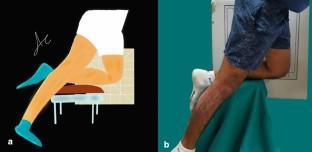Indian Journal of Orthopaedics ( IF 1 ) Pub Date : 2022-08-12 , DOI: 10.1007/s43465-022-00721-5 Quamar Azam 1 , Abhishek Chandra 1 , Bhaskar Sarkar 1 , Balgovind S Raja 2 , Anjum Syed 3

|
Introduction
Diagnosing postero-lateral knee instability is a challenge from both clinical and radiologic perspective and can lead to significant morbidity if left untreated. Delayed diagnosis leads to a more demanding surgery and prolonged rehabilitation for the patient. Kneeling stress radiograph is a lost art but remains invaluable in the assessment of postero-lateral knee instability.
Methods
This prospective observational study is aimed at re-exploring the undeniable utility of this forgotten tool in early diagnosis of posterolateral knee instability and identifying the mean posterior tibial translation distance (PTTD) and also assessing side to side difference (SSD) between the injured and the contralateral normal knee.
Results
Total 27 patients were included in the study, with males being 4.4 times more commonly injured as compared to females. The most common mode of injury was motor vehicle accident (MVA). Out of 27 patients, 11 had isolated PCL (posterior cruciate ligament) injury while the rest had PLC (posterolateral corner) involvement. The mean SSD of PTTD was 8.79 mm in patient with isolated PCL. This was increased by 1.65 times (14.52 mm) in patients with co-existing PLC involvement.
Conclusion
Stress radiography is an indelible tool and serves as an adjunct to MRI imaging. It is not a substitute for clinical assessment but assists in early diagnosis and management, facilitating surgical planning and furnishing objective evidence of PCL/PLC functionality which is not possible with any other imaging modality.
中文翻译:

跪式应力射线照相:一种被遗忘但可靠的治疗膝关节后外侧不稳定的工具
介绍
从临床和放射学角度来看,诊断膝关节后外侧不稳定性都是一个挑战,如果不及时治疗,可能会导致严重的发病率。延迟诊断会导致手术要求更高,患者的康复时间也更长。跪姿应力射线照相是一门失传的艺术,但在评估膝关节后外侧不稳定方面仍然具有无价的价值。
方法
这项前瞻性观察性研究旨在重新探索这种被遗忘的工具在膝关节后外侧不稳定的早期诊断中不可否认的效用,并确定平均后胫骨平移距离(PTTD)以及评估受伤者和受伤者之间的左右差异(SSD)对侧正常膝关节。
结果
该研究共纳入 27 名患者,其中男性受伤的几率是女性的 4.4 倍。最常见的伤害方式是机动车事故(MVA)。27 名患者中,11 名患有孤立性 PCL(后十字韧带)损伤,其余则有 PLC(后外侧角)受累。孤立性 PCL 患者的 PTTD 平均 SSD 为 8.79 mm。在同时存在 PLC 受累的患者中,该值增加了 1.65 倍(14.52 mm)。
结论
应力射线照相是一种不可磨灭的工具,可作为 MRI 成像的辅助手段。它不能替代临床评估,但有助于早期诊断和管理、促进手术计划并提供 PCL/PLC 功能的客观证据,这是任何其他成像方式无法实现的。


























 京公网安备 11010802027423号
京公网安备 11010802027423号